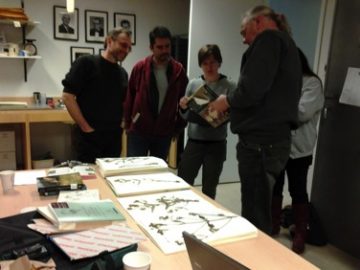UBC Herbarium research associate Dr. Terry McIntosh and I ran a workshop for Katzie First Nation Traditional Resource Specialist Roma Leon and Environmental Technician Paul James on rare plant identification.
The Katzie First Nation are made up of five different reserves; Pitt Meadows, Langley, on Barnston Island in Surrey, Pitt Lake and their graveyard in Maple Ridge. The word Katzie means “land of moss” in Katzies traditional downriver dialect of Halq’emeylem.
Under a grant from Environment Canada’s Aboriginal Fund for Species at Risk, Roma and Paul are working towards habitat restoration within the Alouette and Pitt River watersheds for species at risk, and for culturally valued plants.
Roma states “Working with “species at risk” is very important to us. We have seen a great decline in the native plants within our traditional territory, such as wapato, bog cranberry, crab apple, tule and rushes and many more. Unfortunately we have also seen an increase in invasive plants within our traditional territory such as Policemans helmet, Knotweed, Yellow Iris, Canary Grass and many more. Our concern is not only focused on culturally valued plants but on all plants that are at risk in our territory. We realize that some plants complement each other in the growing process and work together in keeping the necessary balance.”

Dr. Terry McIntosh introduced Tomasz, Paul, Kelly and Roma on how to identify the rare British Columbia beggarticks, Bidens amplissima by comparing herbarium specimens and taxonomic treatments. Terry shows the similarities and differences between species that are most often confused with this rare BC plant including Bidens cernua, a widespread common species and Bidens tripartita, an exotic to BC.

Herbarium sheets can be used in training to show the similarities and differences in morphological characters that can be used to distinguish between the different species.
This is one of the many ways a natural history collection like ours can be used. By having a comprehinsive reference collection of the rare species in our province, it means that they can be used as a reference without putting the organism at risk by picking it to be ID’ed. Also, being able to see all these species that grow in different ecosystems and regions all over BC or Canada all in one place is a real advantage to having such a large and old collection as ours.

The project is supported with input from local ecologists, including wildlife ecologist Dr. Kelly Squires and vegetation ecologist Dr. Tomasz Gradowski. This work is in partnership with an ongoing multi-partnered restoration project, supported by BC Hydro, BC Ministry of Forests, Lands and Natural Resource Operations, the BC Conservation Foundation, and the Alouette River Management Society (ARMS).
